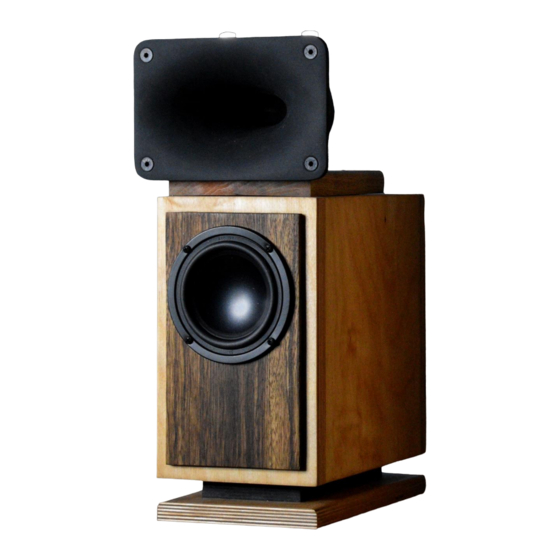
Advertisement
Quick Links
Advertisement

Summary of Contents for Shinjitsu Audio Little Hiro
- Page 1 Shinjitsu Audio Little Hiro Manual...
- Page 2 TABLE OF CONTENTS PAGE 2________________________________________________________ _Table of Contents PAGE 3 Placement PAGE 4________________________________________________________ Room Size/Toe in PAGE 5 Rake/Tilt PAGE 6 ____________________________________________________ _ _Speaker height PAGE 7 _______________________________________________________ _ _ _Crossover PAGE 8 Horn Resistor PAGE 9_______________________________________ Horn connections PAGE10 Specifications...
- Page 3 Placement: Speakers should be placed equidistance from side wall, if possible, with at least 5 feet between them and ideally 24 inches or more from wall. Stands od 16 inches are recommended although floor placement tilted back creates deeper bass. Speaker should toe in approximately 15 degrees or having the main drivers placed just outside your ears.
- Page 4 Toe in: Speaker toe in can be defined as: pointing a loudspeaker inward toward the listener rather than aiming it straight ahead. Toeing-in the speakers can reduce the apparent size of the sound stage but allows more precise image definition. When toed-in, the speakers provide a more focused and sharply delineated soundstage.
- Page 5 Too little tilt back can do the same. Ideally tilt should be adjusted using wooden blocks under the speaker front or by purchasing out Shinjitsu Audio Plinth. Tilt should be from 10 degrees to 15 degrees. This tilt will affect the polar response of the speaker as shown below:...
- Page 6 Speaker Height: These speakers are designed to be floor standers. They must be placed on the floor to produce adequate bass reinforcement. Sever loss of bass will occur if they are placed onto speaker stands. Stereo imaging can be adjusted by using tilt back and back wall placement.
- Page 7 Crossover: This speaker utilizes a third order crossover for the bass and first order for the horn. Polarity for the horn is reversed. There is but two coils and one capacitor for the main driver and one Solen Fast Metallized Polypropylene Capacitor on the high frequency horn to attenuate the upper mid and high frequencies.
- Page 8 Attenuation Resistor The speaker is supplied with a high frequency attenuation resistor accessible via the back-plate terminals. It is available for you to set the high frequency balance to suit your tastes and room. Lower values of resistor increase the high frequencies and higher values of resistors decrease the high frequencies.
- Page 9 Horn connection The horn driver attachments are as follows: Black wire to the left terminal as seen from the REAR of the speaker. The red wire is attached to the Left terminal. Just behind the terminal lies the attenuation resistor # 2. This is a small value and can be changed. Larger values increase treble and smaller values decrease it.
- Page 10 • Frequency Response: 32Hz to > 20 Khz +3 or -3 db. • Frequency response graph at 3 meters using Omni Mic Frequency response at 1 meter distance from speaker and on 24 -inch stands. Copyright 2019 Shinjitsu Audio www.shinjitsuaudio.com...



Need help?
Do you have a question about the Little Hiro and is the answer not in the manual?
Questions and answers